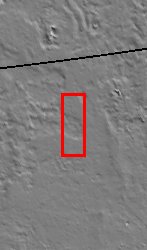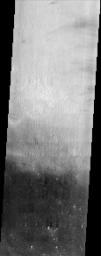
Arcadia Planitia occupies a region just north of Amazonis Planitia, one of the brightest and dustiest regions on Mars. Along the boundary between these two regions is a dark splotch roughly 600 km long that is relatively free of dust. This THEMIS image straddles the border of the dark splotch, producing the dramatic change in brightness from north to south. Note that many of the small craters in the dark portion of the image contain bright material on their floor. It may be that a mantle of dust has been stripped back revealing the dark surface of the splotch but the crater floors have retained the dust. Alternatively, the bright material may represent a more resistant unit that once covered the area and is difficult to erode from the crater floors. Either way, the presence of the bright material in so many craters produces a scene that is quite unusual for the surface of Mars.
Note: this THEMIS visual image has not been radiometrically nor geometrically calibrated for this preliminary release. An empirical correction has been performed to remove instrumental effects. A linear shift has been applied in the cross-track and down-track direction to approximate spacecraft and planetary motion. Fully calibrated and geometrically projected images will be released through the Planetary Data System in accordance with Project policies at a later time.
NASA's Jet Propulsion Laboratory manages the 2001 Mars Odyssey mission for NASA's Office of Space Science, Washington, D.C. The Thermal Emission Imaging System (THEMIS) was developed by Arizona State University, Tempe, in collaboration with Raytheon Santa Barbara Remote Sensing. The THEMIS investigation is led by Dr. Philip Christensen at Arizona State University. Lockheed Martin Astronautics, Denver, is the prime contractor for the Odyssey project, and developed and built the orbiter. Mission operations are conducted jointly from Lockheed Martin and from JPL, a division of the California Institute of Technology in Pasadena.

 Planetary Data System
Planetary Data System













